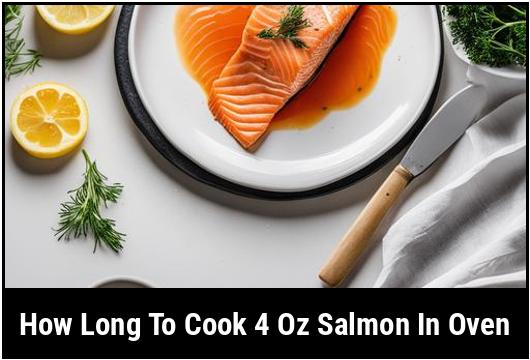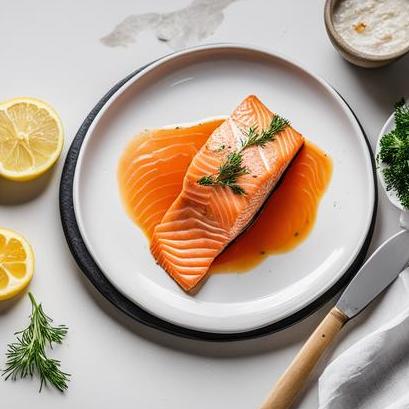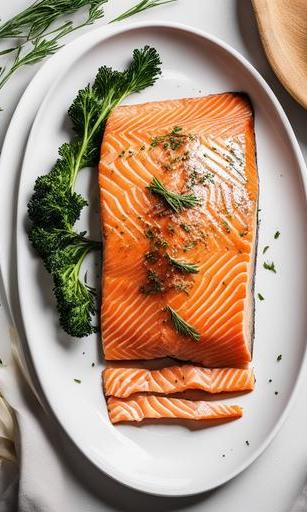[GUIDE] How Long To Cook 4 Oz Salmon In Oven

Salmon is a delicious and nutritious fish that can be cooked in a variety of ways. One popular method is to cook salmon in the oven, which results in a moist and flavorful dish. But how long should you cook a 4 oz salmon fillet in the oven? In this article, we will explore the ideal cooking time for a 4 oz salmon fillet and provide you with tips and tricks for achieving the best results.
Quick Answer: How Long To Cook 4 Oz Salmon In Oven
The general rule of thumb for cooking salmon in the oven is to bake it at a temperature of 375°F (190°C) for about 12-15 minutes. However, the exact cooking time can vary depending on the thickness of the fillet and personal preference. To ensure that your salmon is cooked to perfection, it is important to monitor the internal temperature with a meat thermometer. The salmon should reach an internal temperature of 145°F (63°C) before it is considered safe to eat.
Key Takeaways
- The recommended cooking time for a 4 oz salmon fillet in the oven is approximately 12-15 minutes at 375°F (190°C).
- Use a meat thermometer to ensure the salmon reaches an internal temperature of 145°F (63°C) for safe consumption.
- The thickness of the salmon fillet can affect the cooking time, so adjust accordingly.
- Cooking salmon to medium doneness (slightly pink in the center) will result in moist and flavorful fish.
The Science Of Cooking Salmon

Before diving into the specifics of cooking salmon, it is helpful to understand the science behind it. Salmon is a delicate fish with a high protein content and a moderate fat content. Overcooking salmon can cause it to become dry and tough, while undercooking can result in an unpleasant texture and potential health risks.
When salmon is cooked, the heat causes the proteins to denature and coagulate, resulting in a firm and opaque texture. The fats in salmon, especially healthy omega-3 fatty acids, start to melt during cooking, adding flavor and moisture to the fish. Finding the perfect balance between doneness and moisture is the key to a perfectly cooked salmon fillet.
Choosing Salmon
When it comes to cooking salmon, selecting a high-quality fillet is essential. Here are some tips to help you choose the best salmon for your recipe:
-
Freshness: Look for fillets that are firm, shiny, and have a mild oceanic smell. Avoid fillets with any signs of sliminess or a strong fishy odor.
-
Color: Wild-caught salmon tends to have a deeper red or orange color, while farm-raised salmon is usually lighter in color. Both types are suitable for cooking, but the color can be an indication of the fish’s diet and environment.
-
Skin: Opt for salmon fillets with the skin intact as the skin helps to hold the fish together and adds flavor during cooking. However, if you prefer skinless fillets, make sure they are still moist and fresh-looking.
-
Sustainability: Choose salmon that is sustainably sourced to support responsible fishing practices and protect the environment. Look for certifications such as the Marine Stewardship Council (MSC) or the Aquaculture Stewardship Council (ASC).
Preparing Salmon

Before cooking the salmon, there are a few preparation steps that should be followed:
-
Thawing: If your salmon is frozen, make sure to thaw it completely before cooking. The best method for thawing is to place the salmon in the refrigerator overnight. If you’re short on time, you can also use the defrost function on your microwave or place the salmon in a sealed plastic bag and submerge it in cold water.
-
Seasoning: To enhance the flavor of the salmon, season it with your favorite herbs, spices, and marinades. A simple combination of salt, pepper, and lemon juice can work wonders. Allow the salmon to marinate for at least 15 minutes before cooking to allow the flavors to penetrate the fish.
-
Patting dry: Before cooking, pat the salmon dry with a paper towel. Moisture on the surface of the fish can prevent it from achieving a crispy exterior when baked.
Ideal Cooking Temperature For Salmon
The ideal cooking temperature for salmon is 375°F (190°C). At this temperature, the fish will cook evenly without becoming too dry or undercooked. The higher heat helps to caramelize the natural sugars in the fish, adding a delicious depth of flavor. However, it is worth noting that cooking times may vary depending on your oven and the thickness of the salmon fillet.
Salmon Cooking Time

The cooking time for a 4 oz salmon fillet depends on various factors, including the thickness of the fish. As a general guideline, a 4 oz salmon fillet that is about 1 inch thick should be cooked for approximately 12-15 minutes. However, the following table can help you determine the approximate cooking time based on the thickness of the fillet:
| Salmon Fillet Thickness | Cooking Time |
|---|---|
| 1/2 inch (1.3 cm) | 9-11 minutes |
| 1 inch (2.5 cm) | 12-15 minutes |
| 1 1/2 inches (3.8 cm) | 14-16 minutes |
| 2 inches (5.1 cm) | 16-18 minutes |
These cooking times are estimates and should be used as a starting point. It is important to check the internal temperature of the salmon to ensure it is properly cooked.
Cooking Techniques
There are various techniques you can use to cook your 4 oz salmon fillet in the oven. Here are a few popular methods:
-
Baking: This is the most common technique for cooking salmon in the oven. Preheat the oven to 375°F (190°C) and place the salmon fillet on a parchment-lined baking sheet. Bake for the recommended time and check the internal temperature with a meat thermometer.
-
Roasting: Roasting salmon at a slightly higher temperature can yield a caramelized crust and a tender interior. Preheat the oven to 400°F (200°C) and place the salmon on a baking sheet. Roast for about 10-12 minutes, checking for doneness.
-
En Papillote: This French cooking technique involves wrapping the salmon in parchment paper or aluminum foil before cooking. This method helps to seal in moisture and infuse the fish with flavor. Preheat the oven to 375°F (190°C), place the seasoned salmon on a sheet of parchment paper or foil, and fold it tightly to create a packet. Bake for the recommended time and open the packet to check for doneness.
Monitoring And Troubleshooting

It is crucial to monitor the cooking process to ensure that your salmon is cooked to perfection. Here are some tips for monitoring and troubleshooting:
-
Internal Temperature: Use a meat thermometer to check the internal temperature of the thickest part of the salmon. It should reach 145°F (63°C) before it is considered safe to eat. If the salmon is not fully cooked, continue baking and recheck the temperature every few minutes.
-
Texture: The texture of the salmon can also provide clues about its doneness. When properly cooked, the salmon should be opaque and flake easily with a fork. It should no longer appear translucent or raw in the center.
-
Color: Salmon cooked to medium doneness will have a slightly pink center. If you prefer your salmon cooked through, it will be opaque and light pink throughout. Avoid overcooking, as it can result in a dry and less flavorful fish.
Salmon Cooking Instructions
To cook a 4 oz salmon fillet in the oven, follow these step-by-step instructions:
-
Preheat your oven to 375°F (190°C).
-
Place the salmon fillet on a parchment-lined baking sheet.
-
Season the salmon with your desired herbs, spices, and marinade. Allow it to marinate for at least 15 minutes.
-
Pat the salmon dry with a paper towel to remove any excess moisture.
-
Place the baking sheet in the preheated oven and bake for approximately 12-15 minutes, or until the internal temperature of the salmon reaches 145°F (63°C).
-
Remove the salmon from the oven and let it rest for a few minutes before serving.
-
Serve the salmon hot with your favorite sides and enjoy!
Variations

Once you have mastered the basic cooking method, feel free to experiment with different flavors and preparations. Here are a few variations to try:
-
Grilled Salmon: Instead of baking, grill the salmon for a smoky and charred flavor. Preheat the grill to medium-high heat and lightly oil the grates. Place the salmon fillet on the grill and cook for about 4-5 minutes per side, or until the internal temperature reaches 145°F (63°C).
-
Crispy Skin Salmon: For those who enjoy crispy skin, start by searing the salmon fillet in a hot skillet with the skin side down for a few minutes. Transfer the skillet to the oven and cook at 375°F (190°C) for the recommended time, or until the salmon reaches the desired doneness.
-
Asian Glazed Salmon: Brush the salmon fillet with a glaze made from a combination of soy sauce, honey, ginger, and garlic. Bake in the oven at 375°F (190°C) for the recommended time, basting with the glaze halfway through the cooking process.
Feel free to get creative and adjust the cooking times and temperatures based on your preferred level of doneness and the thickness of the fillet.
When Things Go Wrong
Despite your best efforts, sometimes things don’t go as planned. Here are a few common issues that may arise when cooking salmon in the oven and how to troubleshoot them:
-
Undercooked Salmon: If your salmon is undercooked, simply return it to the oven and continue baking at 375°F (190°C) for a few more minutes. Check the internal temperature regularly until it reaches 145°F (63°C).
-
Overcooked Salmon: Overcooked salmon can become dry and less flavorful. To salvage it, you can try serving it with a sauce or dressing to add moisture and enhance the taste.
-
Uneven Cooking: If part of the salmon is cooked while other parts are still undercooked, cover the cooked portion with aluminum foil and continue baking until the rest of the fillet is done.
Remember that practice makes perfect, and with time and experience, you will become more skilled at cooking salmon to your desired level of doneness.
Serving Salmon

Once your 4 oz salmon fillet is cooked to perfection, it’s time to enjoy it! Here are a few serving suggestions:
-
Fresh Sides: Serve the salmon with a refreshing side salad, roasted vegetables, or steamed greens for a healthy and complete meal.
-
Sauces and Dressings: Pair your salmon with a delicious sauce or dressing. Some popular choices include lemon dill sauce, mango salsa, or garlic butter.
-
Grains and Starches: Salmon goes well with a variety of grains and starches, such as quinoa, rice, or roasted potatoes.
-
Herbs and Citrus: Sprinkle some fresh herbs, such as parsley or dill, over the salmon for added freshness. Squeeze a wedge of lemon or lime for a citrusy kick.
Feel free to experiment with different flavors and accompaniments to find your favorite combination.
Best Practices For Salmon Cooking
To achieve consistently great results when cooking salmon, here are some best practices to follow:
-
Avoid Overcooking: To ensure moist and flavorful salmon, avoid overcooking it. Use a meat thermometer to check the internal temperature and remove the salmon from the oven when it reaches 145°F (63°C).
-
Let it Rest: Allow the salmon to rest for a few minutes before serving. This allows the juices to redistribute, resulting in a more tender and succulent fish.
-
Seek High-Quality Ingredients: Choose the freshest and highest-quality salmon you can find. Quality ingredients will always yield better results.
-
Experiment with Seasonings: Don’t be afraid to get creative with your choice of seasonings. Different herbs, spices, and marinades can transform a simple salmon fillet into a gourmet dish.
-
Keep an Eye on Thickness: Adjust the cooking time based on the thickness of the salmon fillet. Thicker fillets will require slightly longer cooking times, while thinner ones will cook more quickly.
Conclusion
Cooking a 4 oz salmon fillet in the oven can yield a delicious and healthy meal. By following the recommended cooking time of approximately 12-15 minutes at 375°F (190°C) and monitoring the internal temperature, you can achieve perfectly cooked salmon every time. Remember to choose high-quality salmon, experiment with seasonings, and let the fish rest before serving. With these tips and techniques, you’ll be able to enjoy moist, tender, and flavorful salmon prepared in the oven.
FAQS
What Is The Ideal Temperature For Cooking 4 Oz Salmon In The Oven?
The ideal temperature for cooking 4 oz salmon in the oven is 400°F.
How Long Should I Cook 4 Oz Salmon In The Oven?
The cooking time for 4 oz salmon in the oven will depend on the desired doneness. As a general guideline, bake it for 12-15 minutes if you want it to be cooked through and 8-10 minutes for medium-rare.
Can I Cook 4 Oz Salmon In Foil In The Oven?
Absolutely! Cooking 4 oz salmon in foil in the oven is a great way to keep it moist and flavorful. Simply wrap the salmon in foil and bake it in a preheated oven.
Should I Leave The Skin On When Baking 4 Oz Salmon In The Oven?
It is a matter of personal preference. Leaving the skin on while baking 4 oz salmon in the oven can help it retain moisture and prevent it from sticking to the pan.
What Are Some Seasoning Options For 4 Oz Salmon In The Oven?
Salt, pepper, lemon juice, honey, garlic, thyme, and dill are popular seasoning options for 4 oz salmon in the oven. You can also use a simple olive oil and lemon zest-based marinade to add flavor.
Sources
About the Author Jenny
I'm Jenny, a housewife with an unwavering passion for food. My culinary journey began with my grandmother's kitchen, and it's now a full-fledged food blog. I've turned my love for cooking into a creative outlet, sharing recipes and stories with a global community of fellow food enthusiasts. It's proof that being a housewife can also mean pursuing your passions and savoring life's delectable moments.
